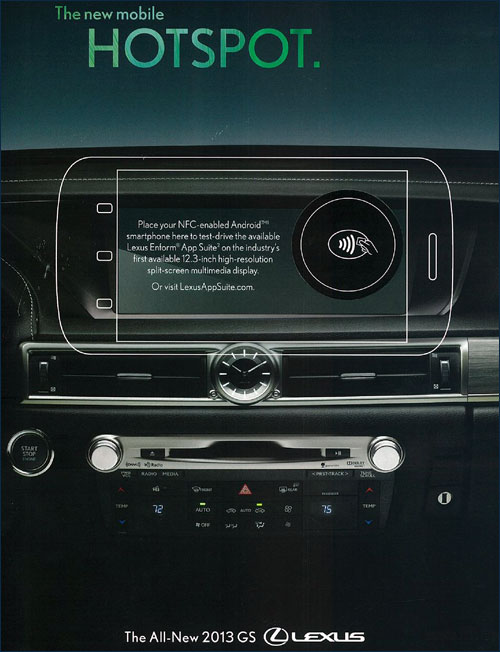Condé Nast‘s Wired magazine makes a policy of being on the cutting edge of technology. So it may not be surprising that its monthly print publication has been among the first to include a Near Field Communication (NFC) RFID tag within its advertising pages. In Wired‘s April 2012 issue, a Lexus car ad comes with a passive high-frequency (HF) tag that consumers with NFC-enabled phones can use to retrieve video and other content on their phone screens regarding the automotive company’s latest offerings. Wired published 500,000 copies of the issue, each with an NFC label attached to the page containing the Lexus ad.
Lexus and its advertising agency, TeamOne, first envisioned the NFC solution—provided by Quad/Graphics, the magazine’s printer—at Condé Nast’s “The Big Idea” conference (an event showcasing technology for the publishing market) in late 2011, according to Matthew Kammerait, Quad/Graphics’ interactive print solutions manager. At that time, Lexus and TeamOne viewed an NFC solution that Quad/Graphics was displaying, and were intrigued with the opportunities it might provide. Quad/Graphics has provided NFC tags in trade-show materials, posters and other promotional items it has printed. Lexus and TeamOne presented the idea of utilizing NFC tags on its advertisements to Wired, which features full-page Lexus ads within its monthly issues. Wired liked the idea. “We’re always looking for ways to push the envelope with emerging technologies, and provide our partners new and creative ways to not only inform our readers, but wow them,” says Jonathan Hammond, Wired‘s executive director of communications.
Advertisers already often provide a 2-D bar code or QR code that smartphone users can scan in order to access data via a URL linked to that code. However, Kammerait notes, such solutions require that a user download an app—and, in some case, have historically been difficult to use. Because the technology has not always worked seamlessly for consumers, he says, those with little free time typically do not want to be bothered with the bar-code scanning app. Quad/Graphics’ NFC solution, linked to content on a URL provided by TeamOne, requires no apps, and thus makes the accessing of data a matter of one simple step: placing the phone within a few centimeters of an RFID inlay.
The inlay consists of an NXP Semiconductors RFID chip with an antenna designed by Quad/Graphics and built by a third-party manufacturer. Quad/Graphics assembled the inlay into an adhesive label that was applied to the Lexus ad in each of the 500,000 copies of Wired‘s April issue.
Applying and testing the tag has required considerable research and innovation on Quad/Graphics’ part, Kammerait says, noting that the company carried out several months’ worth of testing to determine the tags’ durability before applying them to magazine pages. That included putting the tags through washing machines, as well as through a postal process similar to being shipped in a magazine. “We found the tags were really durable,” he states.
The company also designed an automated system to apply the RFID labels to the printed pages, and then tested the tags by reading each one prior to shipment. Kammerait declines to provide details regarding how that was accomplished, but says “the tags did really well” during this process.
When a user places his or her NFC-enabled phone within a few centimeters of the label on the Lexus ad in the April issue, the phone opens a URL listing content concerning the new Enform app suite available with Lexus’ 2013 GS automobile. The content begins with a video describing how the app suite functions, then transitions to a listing of specific applications, prompting users to select those of interest in order to learn more about them. The Enform app suite—designed to run on the 12.3-inch, high-resolution multimedia display built into the dashboard of each new vehicle—includes such online services as Yelp, Pandora, Bing and MovieTickets.com.
While Wired and Quad/Graphics first began planning the NFC advertisement in fall 2011, they opted not to implement the campaign until the April 2012 edition, in order to allow time for more NFC-enabled phones to be released. Although the quantity of NFC-enabled phones used within the United States is still small, Kammerait estimates that the percentage of mobile-phone users equipped with NFC-enabled handsets is slightly higher among Wired‘s readership, and is growing. Approximately five percent of the magazine’s readers currently have NFC functionality on their phones, he says.
Wired and Lexus both have access to TeamOne data regarding the number of times that the NFC-enabled phones have accessed the Lexus URL. Hammond says he does not yet have specific figures indicating users’ response to the tags. “But all feedback, to date, has been positive,” he reports.
In the future, Kammerait says, NFC-enabled advertisement could be used not only to access URLs, but also to provide additional content, and to enable financial transactions. “The sky’s the limit, as far as delivering dynamic content,” he states, adding that content could also be stored on a tag itself, or a user could tap a tag with a phone in order to make a purchase. For example, an advertisement for music or movies could enable cell-phone users to instantly purchase a song or a movie, by tapping their phone against the ad and receiving the product directly on the phone.
According to Kammerait, Quad/Graphics is currently in discussions with other publishing companies and brand owners about how the technology could be further used on advertisements.
Wired is not the first publication to incorporate an RFID tag into its pages. In 2009, a newly launched French periodical called Amusement incorporated an HF RFID tag designed to automatically link consumers to the Internet, where they could then access exclusive interactive online content. The RFID-enabled magazine is a joint effort between a now-defunct French high-tech firm known as Violet and GS1 France. The publication’s tag, which complied with the ISO 14443-B RFID standard, was designed to work with Violet’s Mir:ror, an RFID interrogator that plugged into a computer’s USB port (see RFID News Roundup: RFID-enabled Magazine Connects to the Internet).



